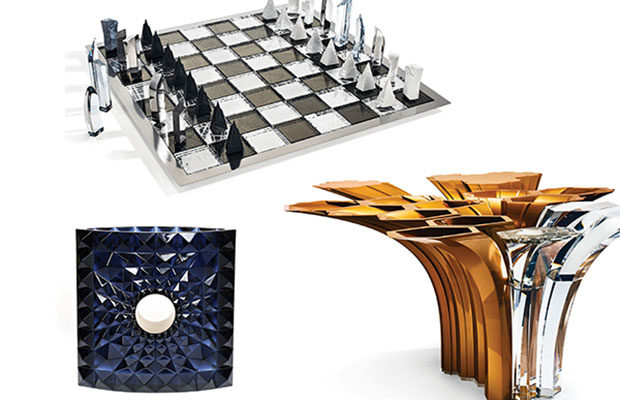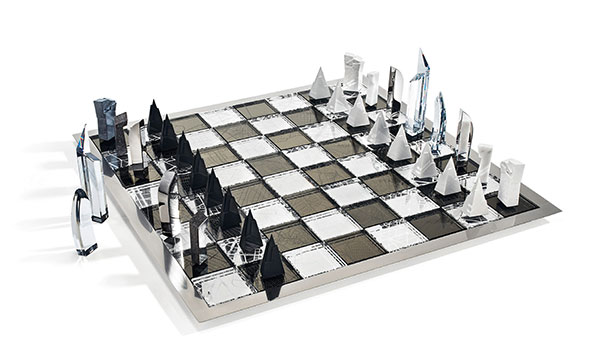 Clockwise from top: Daniel Libeskind for Atelier Swarovski Home, Zaha Hadid for Atelier Swarovski Home. COURTESY SWAROVSKI | Mario Botta for Lalique. COURTESY OF LALIQUE
Clockwise from top: Daniel Libeskind for Atelier Swarovski Home, Zaha Hadid for Atelier Swarovski Home. COURTESY SWAROVSKI | Mario Botta for Lalique. COURTESY OF LALIQUE
Design
The Tabletop Goes Avant- Garde
REMEMBER THOSE MILK GLASS BOWLS and cutglass ashtrays collecting dust on your grandmother’s bookshelf? Well, times have changed and so has tabletop, with such avant-garde designers as Issey Miyake, Daniel Libeskind, Zaha Hadid, and Mario Botta lending their vision to help shake up the market. Atelier Swarovski, Iittala, Lalique, and Lasvit have debuted high-end tabletop lines for the fall of 2016. These companies invited designers to collaborate with their artisans, utilizing centuries-old techniques to create contemporary works that range from elegant to humorous, and can easily be termed functional art.
The elegant and simple designs of Iittala X Issey Miyake reflect both the Japanese and Finnish cultures’ deep respect for nature. Pale pink and light gray suggest Japan’s cherry blossoms, while a deep green reflects Finland’s serene forests. This first home collection for Issey Miyake includes ceramic plates, platters, and cups—in glazes that were developed specially for the line—as well as placemats with Miyake’s signature pleating, and napkins folded in a shape resembling Mount Fuji. Conical glass vases are hand-blown in Iittala’s glass factory, and meant for a single bloom.
Atelier Swarovski Home may be new to this category, but the Austrian company has long been mounting installations at Salone del Mobile and Design Miami, and honors a group of emerging young designers each year as Designers of the Future. Now they’ve commissioned some of the world’s top designers and architects to create tabletop works using crystals and other materials.
Daniel Libeskind’s chess set, Architecture & the City, features a board with maps of New York City and Milan. The chess pieces—in crystal, silver, marble, and concrete—are Studio Libeskind–designed buildings, with his proposed Freedom Tower representing the two kings. The late Zaha Hadid’s massive crystal and metal Crista centerpiece makes an impressive statement utilizing Swarovski’s new “Wave Cut.” Her piece portrays the way crystals form in nature, and the Wave Cut technique, combining computer technology and mechanical engineering, allows the crystals to be cut into curved forms, something that has never been achieved before. Tord Boontje’s Lux Orbit futuristic table lanterns have colored crystals scattered on the glass surfaces, suggesting star formations and colors seen in outer space photography. Boontje uses Corian for the lantern bases (as well as for wine stoppers and a wine cooler). Yael Mer and Shay Alkalay of Raw Edges created the Printed series of vessels that feature Swarovski’s unique laser-jet crystal printing technique, which allows their designs to be printed directly onto the glass. Their designs are given a 360° view, enhanced by the pieces’ faceting.
When René Lalique and family spent time visiting the company’s glass factory in France’s Alsace region, they lived in the house he had built there in 1920. Villa René Lalique is now a hotel, and Swiss architect Mario Botta was commissioned by Lalique CEO Silvio Denz to design its restaurant. While working on the project and spending time with the glass factory’s highly skilled artisans, Botta was inspired to design his Géo vase, utilizing the company’s legendary lost-wax method. The architect’s initial sketches for Géo yielded a 15 3⁄4-inch cube that is a study in geometry, with a surface that is richly detailed with straight lines, pyramids, and a perfect circle in the center, and reflects light off every plane. Lalique has produced a limited edition of eight each, in white, black, and midnight blue crystal, created with single-use molds, each piece signed and numbered. A slightly larger version in clear crystal is available in an edition of 250.
Lasvit’s Via Lucis collection, which debuted at Salone del Mobile 2016, brings together cutting-edge designers, architects, and world-renowned glass artist Stanislav Libenský, and includes vessels, lighting, sculpture, and plenty of tabletop objects. Patricia Urquiola explored the possibilities of Lasvit’s glass-cutting techniques to give her vessel a modern twist. Her heavy lead crystal Radiant vase showcases the company’s high level of expertise in this area. Its intricate cuts are made on a cold-working machine and hand-polished to keep the edges sharp, greatly increasing its light refraction. Arik Levy’s Crystal Rock vases appear to be cut from chunks of glass, but are moldblown, then cut and polished to create the facets and angles.
Designers find inspiration in many places, and Brazil’s Campana Brothers chose the candy they saw in their country’s markets for their Candy lighting series. Their Candy vessels complement the lighting with the same bright colors and shapes. Michaela Mertlová also had a sweet idea when it came to her Munchies. She turned bubblegum into an objet d’art, not just with glassblowing but also by utilizing a metal casting of her own teeth to make the pieces even more realistic.
Glass is often referred to as a “supercooled liquid,” although it’s really an amorphous solid. Maxim Velčovský wanted to illustrate the process of water turning into ice for his Frozen line by having the glassworker flow the molten glass over a metal form. And following another natural occurrence, Petra Krausová and Libor Sošťák imagined the impact of the asteroid that created Bavaria’s Ries Crater and the explosion that resulted in the unearthly green glass called moldavite, found almost exclusively in the Czech Republic. Their Intergalatic Dynamic Sculpture is made of bright green uranium glass, and has more than fifteen hundred hand-blown elements. The lighting can be controlled using a smart phone or tablet.
Can you use a broken vase? Yes, if it’s from Jakub Berdych’s Born Broken line. Glass breaks, of course, and deliberately breaking a piece after it’s been created, reheating it, and joining the pieces back together to make it appear as if it’s still broken illustrates the mastery of this medium by Lasvit’s glassblowing team.

Daniel Libeskind’s Architecture & The City chess set for Atelier Swarovski Home, in concrete, marble, silver, and Swarovski crystal. | COURTESY SWAROVSKI










